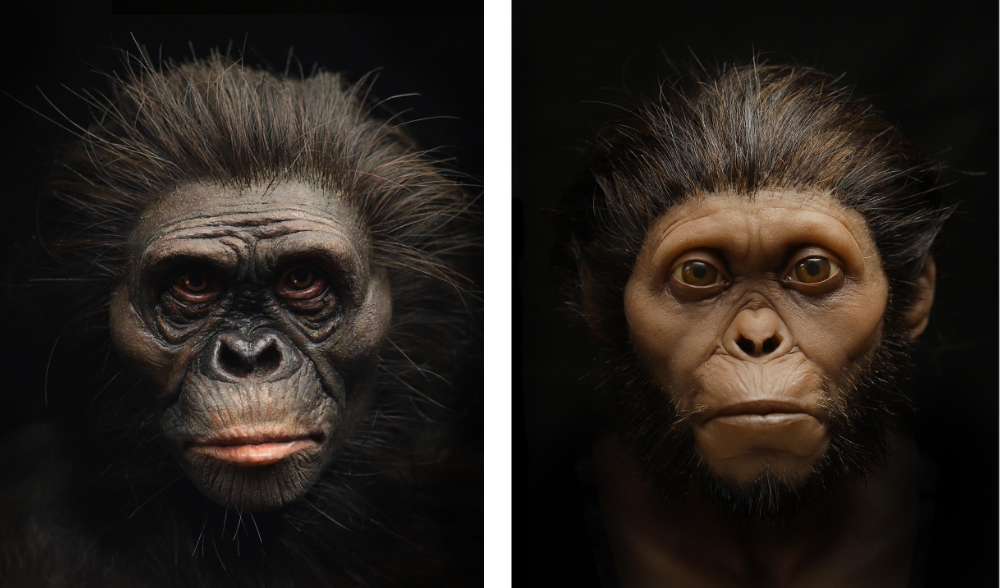Ancestor bias
Museum depictions of ‘human ancestors’ challenged—by evolutionists

Right: The Taung child reconstructed similarly to ‘Lucy’, but with crucial differences in eyes and skin tone (all of which are from imagination) that gives it a ‘more human’ look than the Lucy reconstruction here. Such illustrative licence could have just as readily made Lucy look the more ‘advanced’ of the two.
A team of researchers recently looked at artistic renderings of humans’ alleged ape-like ancestors. They openly discussed a wide range of issues of concern in how these are depicted.1
The team noted that there have been very few ‘hominin’ fossils ever found. In fact, they highlighted that the total number of finds is less than the number of anthropologists active today. So, comparing reconstructions of the small number of individual hominin finds is relatively easy.
Lead researcher Ryan Campbell wrote, “I expected to find consistency in those reconstructions displayed in natural history museums, but the differences, even there, were so severe that I almost thought all previous practitioners had never encountered a single hominid reconstruction before commencing their own.”2
Examples of issues in such reconstructions included skin colour, placement of the eyeballs in the sockets, eyebrow position, nose/nostril shape, mouth width, hair length and distribution, and ear size. All these can greatly change the appearance of the face, making it look more ape- or human-like, depending on the artist’s preconceived ideas. Soft tissue is not a feature of any hominin fossils yet discovered. So, reconstructing how they looked in life is based on taking averages from humans or great apes, plus artistic interpretation.
The researchers were concerned that there was very little empirical evidence backing up how such reconstructions were done. The team decided to reconstruct two of the most famous supposed ape ancestors. One was ‘Lucy’ (Australopithecus afarensis), from an alleged 3.2 million years ago (mya). The other was the ‘Taung child’ (Australopithecus africanus), which died at around 3 years of age, supposedly 2.8 mya. To highlight some of the differences, and the subjective nature of it all, two versions of the Taung child were created. One was more apelike, the other more humanlike.
Lucy was not so easy to reconstruct as most of her cranial bones are missing. They used her jaw, and scaled down a skull from a much larger male (which did not perfectly fit) to make their reconstruction, and applied human skin thickness.
Highlighting bias
The team then applied skin tone to each—Lucy’s similar to that of a pygmy chimp and the Taung child to that of modern South African humans (see picture). The highly subjective nature of the reconstructions were presented in the research paper.
In addressing their original question about museums they suggested that while their artistic renditions are technically impressive, “There are potential educational harms in presenting unscientific reconstructions of hominins under the shroud of presumed validity.” They suggested that the reasons for museums doing so “can most likely be attributed to factors outside the control of science”.3
In wanting to appear to present a coherent and convincing story of evolution, a great deal of ‘scientific/artistic licence’ is inappropriately used in ‘hominin’ reconstructions. The Bible is clear that man did not evolve from any ape ancestor, but rather was specially created in God’s image. All australopithecines like these are an extinct group of apish primates not on the human ancestral line. This has been conceded by even some evolutionist experts, who point out that their unique anatomy was not ‘in between’ humans and great apes. In fact, australopithecines in many respects “clearly differ more from both humans and African apes, than do these two living groups from each other. The australopithecines are unique.”4 Also, they did not, as many believe, walk upright in the human manner.5
References and notes
- Campbell, R.M. and 3 others, Visual depictions of our evolutionary past: A broad case study concerning the need for quantitative methods of soft tissue reconstruction and art-science collaborations, Ecol. Evol. 26 Feb 2021. Return to text.
- Geggel, L., Human ancestor ‘Lucy’ gets a new face in stunning reconstruction, livescience.com, 3 Mar 2021. Return to text.
- Campbell, R.M. et al., ref. 1. Return to text.
- Oxnard, C., Fossils, Teeth and Sex: New Perspectives on Human Evolution, Hong Kong University Press, Hong Kong, p. 227, 1987. Charles Oxnard (b. 1933) is Emeritus Professor at the University of Western Australia and one of the most distinguished living anatomists in the field of human evolution. Return to text.
- Oxnard, C.E., Nature 258:389–395, 1975. Return to text.






Readers’ comments
Comments are automatically closed 14 days after publication.